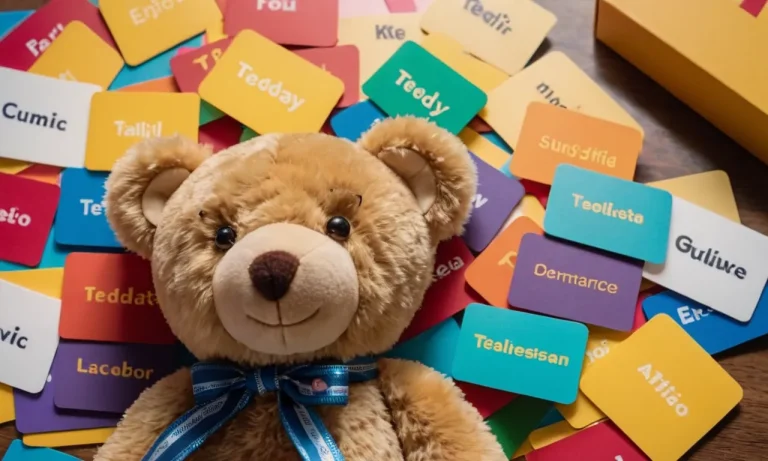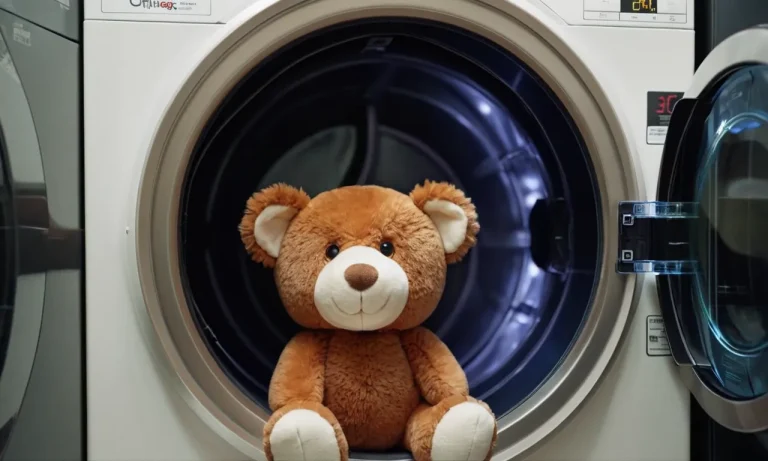Warmies are super soft and cuddly stuffed animals that have an inner pouch filled with grains, dried beans, or rice that can be heated in the microwave to provide soothing warmth and comfort. If you’ve ever wondered what exactly is inside one of these cozy critters, you’ve come to the right place!
Here’s the quick answer: Warmies are filled with a natural grain or dried bean filling, usually flax seed, wheat, rice, or a blend. The inner pouch containing the fill is made of natural fabrics and sits inside the outer stuffed animal shell made of plush fabrics.
When heated, the natural filling provides safe, long-lasting warmth and a weighted feel that many find comforting to hold or rest against sore areas of the body.
In this comprehensive guide, we’ll explore everything about the inside of a Warmies stuffed animal – from the type of fillings used to how the microwavable heating works. We’ll also overview the outer shell fabrics and discuss care and safety considerations for your Warmie.
Common Warmie Fillings
Flax Seed
Flax seed is a popular microwaveable heat pack filling used in many Warmies plush toys. When heated, the flax seeds release moisture to provide soothing warmth that lasts. Flax is a natural, biodegradable material that conforms nicely to the body.
According to the Warmies website, their flax seed-filled animals can retain heat for up to 30 minutes when microwaved for 1-2 minutes.
Wheat
Like flax seeds, bags of wheat grains make excellent reusable heat packs that mold to the contours of the body. Wheat is affordable, widely available, and all-natural. As per this DIY wheat heating pad guide, a microwaveable sock filled with 1-2 cups of wheat can stay warm for up to 45 minutes, allowing the warmth to deeply penetrate sore muscles.
Rice
Rice is sometimes added to flax seed Warmie fillings for extra heat retention. The Axolotl Warmie, for example, contains a rice and flaxseed blend that provides over 30 minutes of soothing warmth when heated according to directions.
Being completely natural, rice-filled microwavable stuffed animals are a safe, non-toxic way to apply therapeutic warmth to the body.
Dried Beans
Varieties of dried beans, like pinto, kidney, garbanzo, and black beans, are economical alternatives for heat pack fillings. An advantage of bean-filled heating pads is that they tend to be heavier and denser than other fillings, allowing them to better distribute heat and pressure.
As with other natural fillings, reusable bean bags should be heated 1-2 minutes to provide sustained warmth without getting excessively hot.
Proprietary Blends
Some Warmies contain special mixtures of grains, seeds, dried flowers, and herbs designed for optimal heat retention. For example, the Winky Monkey Warmie’s proprietary filling allows it to stay warm for over 1 hour and cool to the touch in 24 hours after microwaving.
With non-toxic, hypoallergenic contents, these specialty fill blends provide safe, long-lasting pain relief and comfort for both kids and adults.
Fill Pouches and Fabrics
Warmies are made with two key components that work together to provide comfort and warmth – the inner fill pouches and the outer plush fabrics.
Fill Pouches
The secret to Warmies’ soothing warmth comes from the removable heat packs tucked inside their pouches. These philanthropy fill pouches contain all natural grain and dried French lavender that retains heat and emits a delicate, relaxing aroma when microwaved or cooled.
The grain acts as a natural thermal conductor while the dried buds infuse the air with calming lavender essence. The combination gently envelopes your senses for full-body tranquility.
The fill pouches are made from lightweight, breathable materials like cotton so warmth radiates through slowly and evenly. Pouches come in different shapes and sizes to fit snugly inside each Warmies design.
Outer Fabrics
On the outside, Warmies plushie covers are meticulously constructed from soft, huggable artisanal fabrics like faux fur, flannel, velour and minky.
These comforting textiles feel amazing against bare skin. Their sensory qualities ease anxiety and lull you into a relaxed state of being for better quality slumber.
From magical unicorns to cuddly cats, all Warmies characters feature beautifully stitched facial details and accessories. Each one has its own lively personality!
Warmies fabrics are also durable and machine-washable so you can snuggle up with your favorite one over and over.
Together, the natural fill pouches and huggable plush fabrics create an unparalleled sensory experience that comforts both body and mind. It’s like getting a warm, scented hug whenever you need one!
Heating Features and Instructions
Heating Time
Warmies take between 1-2 hours to fully heat up, depending on the size of the stuffed animal. The heating process happens gradually as the plush absorbs the heat from the inner wheat bag. A standard 7-inch Warmie will be warm to touch within 30-45 minutes, while larger 12-inch stuffed animals may take the full 2 hours to fully retain the warmth.
It’s safe to microwave the Warmie for up to 2 minutes at a time to restart the heating process. Do not microwave for more than 2 minutes continuously, as this can risk overheating or damage. Gently knead the Warmie after microwaving to evenly distribute the warmth throughout the plush exterior.
Checking Temperature
Always check the temperature of your Warmie before prolonged skin contact, especially for children or elderly users. The surface should feel pleasantly warm to the touch, but not get uncomfortably hot. Safe surface temperatures generally fall between 100-113°F (38-45°C).
You can use a non-contact infrared thermometer to get an exact external temperature reading. Check multiple spots on the Warmie’s surface to ensure even heat distribution without any hot spots exceeding 120°F (49°C). Discontinue microwaving if temperatures climb higher despite short heating times.
Reheating
The warming effects of the Warmie will slowly decrease over time after the initial heating session. The rate of heat loss depends on the ambient room temperature and surface area of the stuffed animal.
In general, you can expect a standard 7-inch Warmie to stay warm for 1-2 hours before needing to reheat.
When ready to reheat, follow the same microwaving instructions to quickly restore warmth. There’s no harm in topping up your Warmie whenever you please! Repeated reheating will not degrade the heatable fill or plush material.
Most Warmie products come with an average lifespan of 10+ years with proper care.
| Warmie Size | Initial Heating Time | Heat Retention Duration |
|---|---|---|
| 7 inch | 30-45 minutes | 1-2 hours |
| 12 inch | 1-2 hours | 3-4 hours |
Outer Shell Fabrics
Plush Fabrics
The exterior of Warmies stuffed animals is usually made from soft, plush fabrics like faux fur or velour. These cozy textiles create a soothing, huggable texture that kids and adults love. Many Warmies use super-silky faux fur that feels great against sensitive skin.
For some designs, they select ultra-plush velour with an almost towel-like pile for maximum squishiness.
Organic Cotton
Some Warmies outer shells utilize natural, breathable organic cotton. This sustainable fabric offers a smooth, lightweight feel and comforting warmth. Organic cotton is grown without toxic pesticides and extracted through gentler processing methods than conventional cotton.
Using eco-friendly textiles aligns with Warmies’ commitment to creating safe, non-toxic plush toys.
Microfiber
Certain Warmies animals feature a microfiber exterior that is durable and easy to care for. Made from extremely fine synthetic fibers, microfiber fabrics withstand frequent washing without pilling. They also lend a subtly glossy appearance to the plush toys.
However, microfiber is less breathable than natural fabrics like cotton. But overall, it makes an excellent shell for Warmies’ heatable plushies.
Care and Safety
Cleaning
Keeping your Warmie stuffed animal clean is essential for maintaining its soft and snuggly feel that makes it perfect for cuddling. Follow the care instructions included with your Warmie. The key guidelines include:
- Most Warmies can be surface washed with a damp cloth and mild detergent.
- Check the fabric label – some Warmies have special cleaning instructions like hand washing or dry cleaning only.
- Do not submerge most Warmies and do not machine wash.
- Thoroughly air dry your Warmie after cleaning and before reheating or reuse.
- For tough stains or spills, spot clean the area as quickly as possible with the damp cloth technique.
With proper care and occasional surface washing, your Warmie can be a cuddly companion for years. If in doubt, check the included directions or warming instructions on the Warmies website for your specific stuffed friend.
Storage
Follow any Warmie-specific storage guidelines in the included instructions. In general, storing your Warmie neatly in a clean, dry location out of direct sunlight will help it maintain top shape.
- Avoid storing in damp garages, basements or attics.
- Store on a shelf or in a bin, not on the floor where it could get dirty or damaged.
- Put the Warmie in a breathable fabric bag before box or bin storage.
- When possible, allow your Warmie to air out before storage so any moisture inside can evaporate.
- Don’t cram too tightly on the shelf – slight compression is fine but completely smashing the stuffing over years can impact fill and warmth.
With some reasonable care in a dry indoor location, most Warmies will store very well for years, ready to deliver cozy comfort whenever you get them out again!
When to Discard
Some signs indicating it may be time to responsibly recycle your well-loved Warmie and purchase a fresh stuffed friend include:
- The fabric exterior is very worn, has holes/tears/broken seams.
- The stuffing is protruding through seams or holes.
- You notice mildew smells even after attempted cleaning.
- The pouch materials inside are damaged.
- Stored improperly, it picked up musty smells that don’t dissipate.
- Heating mechanisms fail even with new batteries.
Your Warmie provides not only physical comfort and warmth, but also emotional comfort. When it’s time, letting it go and finding a new Warmie friend to love can breathe joy into your self-care all over again!
Conclusion
We hope this outline gives you a comprehensive overview into the different fillings, fabrics, heating features, care instructions, and safety considerations for Warmies stuffed animals. With many fill options from natural grains to beans and outer shell fabric choices of super-soft plush, organic cotton, or microfiber, there is a Warmie to suit anyone’s preferences.
Just be sure to follow the heating directions closely and care properly for your Warmie by machine-washing gently and air drying to extend its cozy comforting life!
The next time you snuggle your favorite Warmie, you’ll have an insider understanding of what makes it the perfect warming companion!







